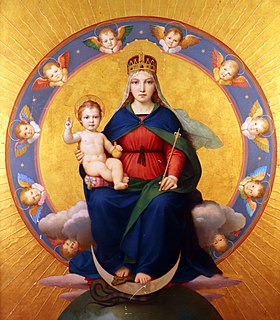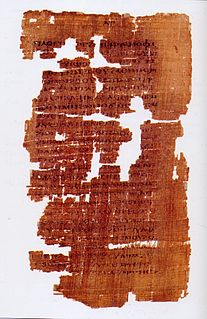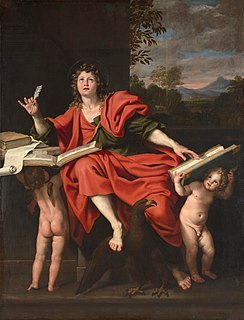The Apocalypse of John is commonly referred to as the Book of Revelation.
Apocalypse of John may also refer to:

Apocrypha are works, usually written, of unknown authorship or of doubtful origin. The word apocryphal (ἀπόκρυφος) was first applied to writings which were kept secret because they were the vehicles of esoteric knowledge considered too profound or too sacred to be disclosed to anyone other than the initiated. Apocrypha was later applied to writings that were hidden not because of their divinity but because of their questionable value to the church. In general use, the word apocrypha has come to mean "false, spurious, bad, or heretical".

The Book of Revelation is the final book of the New Testament. Its title is derived from the first word of the Koine Greek text: apokalypsis, meaning "unveiling" or "revelation". The Book of Revelation is the only apocalyptic book in the New Testament canon. It occupies a central place in Christian eschatology.
Preterism, a Christian eschatological view, interprets some or all prophecies of the Bible as events which have already happened. This school of thought interprets the Book of Daniel as referring to events that happened from the 7th century BC until the first century AD, while seeing the prophecies of the Book of Revelation as events that happened in the first century AD. Preterism holds that Ancient Israel finds its continuation or fulfillment in the Christian church at the destruction of Jerusalem in AD 70.

John the Apostle or Saint John the Beloved was one of the Twelve Apostles of Jesus according to the New Testament. Generally listed as the youngest apostle, he was the son of Zebedee and Salome. His brother was James, who was another of the Twelve Apostles. The Church Fathers identify him as John the Evangelist, John of Patmos, John the Elder, and the Beloved Disciple, and testify that he outlived the remaining apostles and was the only one to die of natural causes, although modern scholars are divided on the veracity of these claims.

The Four Horsemen of the Apocalypse are figures in the Christian religion, first appearing in the Old Testament's prophetic Book of Zechariah and in the Book of Ezekiel, where they are named as punishments from God. They later appear in the New Testament's final book, Revelation, an apocalypse written by John of Patmos.

Apocalypse is a literary genre in which a supernatural being reveals cosmic mysteries or the future to a human intermediary. The means of mediation include dreams, visions and heavenly journeys, and they typically feature symbolic imagery drawn from the Hebrew Bible, cosmological and (pessimistic) historical surveys, the division of time into periods, esoteric numerology, and claims of ecstasy and inspiration. Almost all are written under pseudonyms, claiming as author a venerated hero from previous centuries, as with Book of Daniel, composed during the 2nd century BCE but bearing the name of the legendary Daniel.

Babylon the Great, commonly known as the Whore of Babylon, refers to both a symbolic female figure and place of evil mentioned in the Book of Revelation in the Bible. Her full title is stated in Revelation 17 as "Mystery, Babylon the Great, the Mother of Prostitutes and Abominations of the Earth". Revelation 17 states that the woman is actually a representation of "the great city which reigneth over the kings of the earth".

The Apocalypse of Peter is an early Christian text of the 2nd century and an example of apocalyptic literature with Hellenistic overtones. It is not included in the standard canon of the New Testament, but is mentioned in the Muratorian fragment, the oldest surviving list of New Testament books, which also states some among authorities would not have it read in church. The text is extant in two incomplete versions of a lost Greek original, a later Greek version and an Ethiopic version, which diverge considerably.
The Life of Adam and Eve, also known in its Greek version as the Apocalypse of Moses, is a Jewish apocryphal group of writings. It recounts the lives of Adam and Eve from after their expulsion from the Garden of Eden to their deaths. It provides more detail about the Fall of Man, including Eve's version of the story. Satan explains that he rebelled when God commanded him to bow down to Adam. After Adam dies, he and all his descendants are promised a resurrection.

In the Book of Ezekiel in the Hebrew Bible, New Jerusalem is Ezekiel's prophetic vision of a city centered on the rebuilt Holy Temple, the Third Temple, to be established in Jerusalem, which would be the capital of the Messianic Kingdom, the meeting place of the twelve tribes of Israel, during the Messianic era. The prophecy is recorded by Ezekiel as having been received on Yom Kippur of the year 3372 of the Hebrew calendar.

The New Testament apocrypha are a number of writings by early Christians that give accounts of Jesus and his teachings, the nature of God, or the teachings of his apostles and of their lives. Some of these writings have been cited as scripture by early Christians, but since the fifth century a widespread consensus has emerged limiting the New Testament to the 27 books of the modern canon. Roman Catholic, Eastern Orthodox, and Protestant churches generally do not view these New Testament apocrypha as part of the Bible.
Apocalypse is a genre of revelatory literature, or a large-scale catastrophic event.
The name 'Esdras' is found in the title of four texts attributed to, or associated with, the prophet Ezra. The naming convention of the four books of Esdras differs between church traditions; and has changed over time.

Revelation 1 is the first chapter of the Book of Revelation or the Apocalypse of John in the New Testament of the Christian Bible. The book is traditionally attributed to John the Apostle, but the precise identity of the author is a point of academic debate. This chapter contains the prologue of the book, followed by the vision and commission of John.

Saint Peter, also known as Peter the Apostle, Peter the Rock, Simon Peter, Simeon, Simon or Cephas, was one of the Twelve Apostles of Jesus Christ, and one of the first leaders of the early Church. Based on contemporary historical data, his papacy is estimated to have spanned from AD 30 to his death, which would make him the longest-reigning pope, at anywhere from 34 to 38 years; however, the length of his reign was never verified.

The name John is prominent in the New Testament and occurs numerous times. Among Jews of this period, the name was one of the most popular, borne by about five percent of men. Thus, it has long been debated which Johns are to be identified with which.
Apokalypsis is the Greek word for Revelation. It may refer to:
Baruch may refer to:

The Second Apocalypse of John is a pseudographical Greek Christian text sometimes classified as among the New Testament apocrypha. It is falsely attributed to John of Patmos. Its date is uncertain and has been placed as early as the late fourth century and as late as the mid-ninth.
The Apocalypse of John Chrysostom, also called the Second Apocryphal Apocalypse of John, is a Christian text composed in Greek between the 6th and 8th centuries AD. Although the text is often called an apocalypse by analogy with the similarly structured First Apocryphal Apocalypse of John, the text is not a true apocalypse. It is classified as part of the New Testament apocrypha because it describes an apocryphal encounter between John of Patmos and Jesus. The basic structure, which it shares with the First Apocalypse, is erotapocritic (question-and-answer), but, whereas in the First Apocalypse the questions deal with eschatology, in the Apocalypse of John Chrysostom they mostly concern earthly matters. John asks Jesus about sin, Sundays, fasting, the meaning of the liturgy, deference to priests, baptism, the proper length of hair and love.